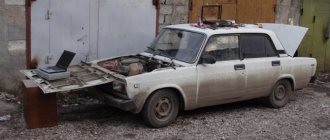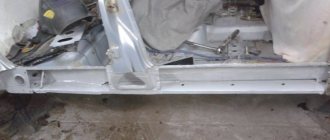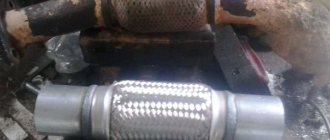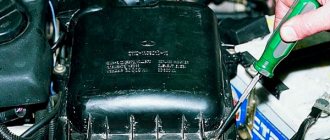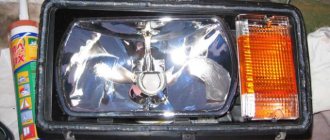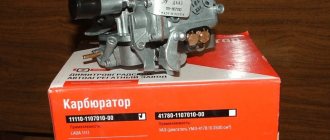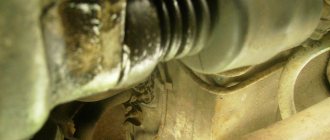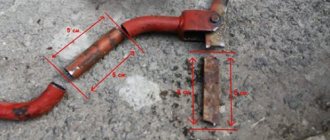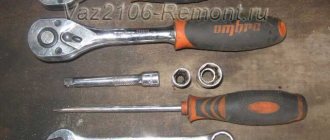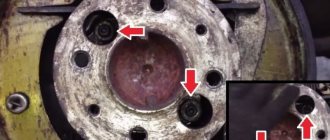Types of car thresholds
Car thresholds are divided into two large groups: removable and non-removable elements. Fixed ones are part of the bottom and perform protective and decorative functions. During the design process, the total force load is calculated on the welded parts of the bottom; the elements increase the overall rigidity of the body and serve as part of the passive safety of the car. Technically divided into front and rear (left and right, respectively), they consist of two parts: a seal and an outer surface.
Removable sills are also part of the body, but do not carry the power load. The parts are attached to the bottom with bolts from the inside of the cabin. This element can be metal, plastic, chrome, or backlit.
Repair of a removable threshold in 90% of cases comes down to a complete replacement of the hinged element. When changing something that is not removable, such a manipulation simply cannot be carried out due to the rigid attachment to the body with welding seams. Let's look at how to repair car sills without welding, depending on the damage.
Rivets
This method not only repairs large holes in the car body, but also replaces parts (fenders, aprons) without welding. In terms of reliability, it is not inferior to welding. It is recommended to install rivets in an inconspicuous place. Since there is no splash of molten metal during operation, like welding, it is often used to repair car floors.
The riveter required for the job can be bought in a store (costs approximately 500 rubles). The technology is simple:
- The patch is cut so that it overlaps 2 cm around the edges of the hole.
- By attaching it to the body, it is given the desired shape.
- The locations of the holes for the rivets are marked.
- After drilling the patch with a drill according to the diameter of the rivets (4 - 6 mm), it is advisable to countersink the edges of the holes so that it fits more tightly to the surface of the car body.
- Having applied the patch again, the center of the first hole is marked and drilled.
- After riveting it and leveling it, the patches are tapped and the remaining holes are drilled in place.
- To ensure a tight fit of the patch to the car body, rivets are fastened from the center to the edges.
- To prevent moisture from getting inside, the joint around the perimeter and rivets is coated with sealant.
What are the defects?
Depending on the degree and type of damage, the repair method is selected. Without welding, it is possible to restore a part in the following cases:
- Dent of a non-removable element, bend of the lower edge. If the dent is shallow and without a sharp edge, then the drawing method, back hammering, and straightening are used.
- A chip in the paintwork with a small area of corrosion. Anti-corrosion metal treatment, stripping, and grinding are used.
- Point-through corrosion can be repaired with epoxy resins and fiberglass patches.
Do-it-yourself repair of rotten thresholds is carried out only by welding. It is necessary to cut out or knock out the rusted metal, weld a patch or a new part of the structure.
Removable elements are repaired only with minimal damage: dents, scratches, chipped paintwork. In case of serious defects, the part is replaced with a new one; the cost of the analog and repair costs are almost the same.
Final stage
Regardless of how the car body was repaired, they all end with putty. However, it absorbs moisture, which leads to rapid destruction. Therefore, it must be coated on top with an anti-corrosion or epoxy primer. Body repairs are completed without welding by painting. To do this, use a spray gun or aerosol cans, after covering the adjacent surface of the car with plastic film. You should not use a brush, as drips are possible.
The proposed methods will help to repair a car without welding in case of single damage. However, if a large area is affected by corrosion, it will be easier and more reliable to contact a car repair shop to replace the rusted area by welding. Most often this happens to the floor, so it is recommended to regularly check it from underneath the car using an inspection hole or lift.
A source of through corrosion, or simply a hole, in the bottom of the car is the price to pay for comfort in the cabin. Its primary source is not anti-icing reagents acting outside, but moisture accumulating under the “pie” of heat, sound and waterproofing. Therefore, when eliminating it, work is carried out mainly from the inside.
If you follow all safety rules when welding, you must completely dismantle the interior, including the trim. This is always very time consuming. Therefore, the question of how to seal the bottom of a car without welding is very relevant. Moreover, most alternative methods do not give worse, but rather better results.
Restoration methods
There are more than ten ways to repair car thresholds with your own hands without welding. With the advent of new samples of glue, resins, protective fibers and equipment, the number of methods is increasing. The most common, simple ones for garage repairs:
- fiberglass treatment;
- epoxy glue;
- construction foam;
- hood without painting;
The use of a reverse hammer, as well as a spotter, are both spot welding repair methods.
fiberglass
Repair using fiberglass or fiberglass is quite simple, cheap, but reliable. Advantages:
- does not interact with reagents on the roads - water, acids, electrolyte;
- has little weight;
- easy to use;
- used for a long time;
- has a low price.
Repairing large-scale damage
Any hole in the threshold of a car indicates the beginning of corrosion, but what to do if the destruction of the metal is large-scale and simple means cannot be avoided? In this case, a gas welding machine is required, a complete digestion of the body, and sometimes a complete replacement of parts of the bottom and wings.
Superficial repairs using putty, fiberglass, and small metal patches will not change the situation dramatically; rotting of the body will continue.
Thresholds and bumpers are considered the most vulnerable parts of a car body. Gravel flying out from under the wheels of the vehicle in front damages the paintwork, and improper crossing of the edge and careless parking lead to dents. Timely repair of thresholds without welding with your own hands will prevent corrosion of the metal and seal and restore the aesthetics of the car.
How to stretch a threshold without welding
Repairing a threshold after a dent involves using a reverse hammer, a suction cup, or cutting the area of deformation for a non-removable element. The algorithm of action is as follows: it is necessary to drill holes with a diameter of 1-2 mm near the dent, insert special metal corner hooks of a reverse hammer into them. Then tapping on yourself straightens the area of deformation.
You can weld by spot welding, placing the end of a hammer on the dent, and drawing out the metal. In this case, you need to start from the corner of the dent, welding the end every 3-5 mm, while straightening the surface with a hammer.
Car body soldering
This method is used to seal small and large holes without welding. To work, you will need flux, which will protect the metal from rapid oxidation. Soldering acid, sold in radio stores, can successfully cope with this task. To achieve the required temperature, you will need a soldering iron with a power of 1 kW or more, or a version heated with a blowtorch, but it is better to use a gas torch. The solder is chosen to be refractory, since it can be used to repair a hole in the car body more reliably.
Small holes are simply filled with solder, starting from the edges and gradually fusing to the center. A large hole in the body is covered with a patch cut from tin from a tin can. It provides:
- strong connection, almost like welding;
- significantly longer service life than putty, but less than welding;
- possibility of sealing large holes;
- ease of implementation, repairs are accessible even to beginners.
The work is performed in the following sequence:
- A patch is cut to fit the size of the hole. The larger the area of contact with the body, the more reliable the connection.
- The soldered edges of the patch and the damaged areas are cleaned with sandpaper until shiny.
- Using flux and solder, the cleaned surfaces are tinned.
- After applying the patch to the repaired area of the car, it is heated to the melting temperature of the solder. In this case, you need to ensure the continuity of the seam so that there are no missing sections.
- After cooling, the remaining flux is removed, and the soldering area is washed with hot water and soda.
Restoration of permanent thresholds
A reliable technology for restoring a permanent threshold remains the application of a metal patch by welding if there are through holes and large corrosion damage. Pull out dents with a reverse hammer or spot welding; chipped paintwork with epoxy resin.
If it is necessary to repair a removable part from primary rust and it is not possible to replace the part, it is recommended to use fiberglass and epoxy glue.
The thresholds are first removed so as not to damage other body parts. Then traces of rust are removed from the surface using a solution. Next, the epoxy resin is diluted with a hardener and applied to a previously degreased surface. Pieces of fiberglass of the required size are placed on the laid glue and pressed down for adhesion. After 12 hours, the area is sanded, uneven areas are removed, a layer of primer is applied, and at the final stage it is painted.
If we are talking about minor damage - rust or dents in a small area, then even beginners can do such repairs. If you lack the skills or desire, it is recommended to contact specialized workshops; tinsmiths will conduct a full inspection of the part and adjacent elements, and will also suggest how to seal the thresholds in the car reliably and quickly.
Common Mistakes
If you have no experience in body repair, you can make mistakes even when correcting minor damage. To prevent them, it is useful to familiarize yourself with the mistakes that beginners and non-professionals make most often.
Common mistakes when repairing thresholds:
- When repairing metal thresholds, the surface is not cleaned properly. The entire outer part and connector must be carefully treated to remove all traces of rust.
- Metal patches welded to thresholds are not treated with anti-corrosion compounds. To prevent the metal from becoming leaky, it must be cleaned and an anti-corrosion compound applied on top. They also need to process the insides of removable thresholds.
- I don't treat the underbody of the car. When repairing, it is necessary to apply protective mastic to it.
- They forget to check the drainage holes. They need to be cleaned and Movil or another preservative must be poured into the cavity of the thresholds.
Every car enthusiast will be able to eliminate minor defects in thresholds, having the necessary tools and materials at hand. If everything is done correctly, you can postpone contacting the service for a couple of years. Complex damage requires the use of welding and certain skills, and if they are not available, it is better to turn to professionals.
Repair of removable structures
Removable thresholds are easy to dismantle and replace. They are convenient and practical to use. They are installed outside or on the side of the side members. Removable thresholds provide effective protection of the underbody of the car from stones.
To repair removable elements, metal or plastic is used. Self-restoration is performed according to the following algorithm :
- Screwing in fasteners.
- Removing the threshold.
- Removing traces of corrosion.
- Applying putty and primer.
- Painting.
After repair work, the parts are mounted to the bottom. If the structure has significant damage, it is completely replaced with a new analogue.
Work technology
The rivet connection method is the fastening of two or more metal sheets using cylindrical rods with heads at the ends. Holes are pre-drilled in the parts to be joined. A rivet, with one head made in advance, is inserted into the hole and the second head is formed. The heads of the rivets pull the sheets together and prevent them from being torn off. The rod of this fastener prevents the lateral mutual displacement of parts and is subject to shearing forces.
Rivet joints are used in body production:
- for securing sheets (of light alloys most often);
- for securing parts made of plastic materials;
- when assembling frames.
During repairs, this method is most often used to replace corroded body cladding when welding is unreliable. Riveted joints are especially common when repairing floors - the damaged area is replaced with a new panel. A properly executed rivet seam is as strong as a welded seam.
Weldless auto repair options
Car body repairs without welding are considered unprofessional, since this is not the product of numerous scientific research. There are several ways.
If the problem is not with the body with the exhaust system, then we advise you to see how to seal the muffler using cement or sealant
General requirements: the damaged area is removed with a grinder or chisel. Anticorrosive and zinc are applied and degreased. Next, the holes are sealed with paint putty, creating a surface of a suitable shape, and painted.
Materials to fix the problem
Net
A special aluminum patch mesh is used as the main material, or a similar non-professional mesh with a fine cross-section is selected. Nowadays, you can get by with ordinary household plastic, metal or fabric mesh.
Several suitable pieces are prepared. By stretching one of them from the inside of the part and giving the necessary shape to the missing part, the mesh is attached using masking tape. Epoxy resin is applied to the mesh layer by layer.
Each layer must dry well. This must be repeated with the next piece of mesh. And so we seal it until we get a hard surface.
Fiberglass
From this material you can make not only a fragment, but also a complete part. The sequence of actions is the same as with the mesh (sealing the rust hole on the car body), but using fiberglass. In fact, the frame of the missing element is created.
